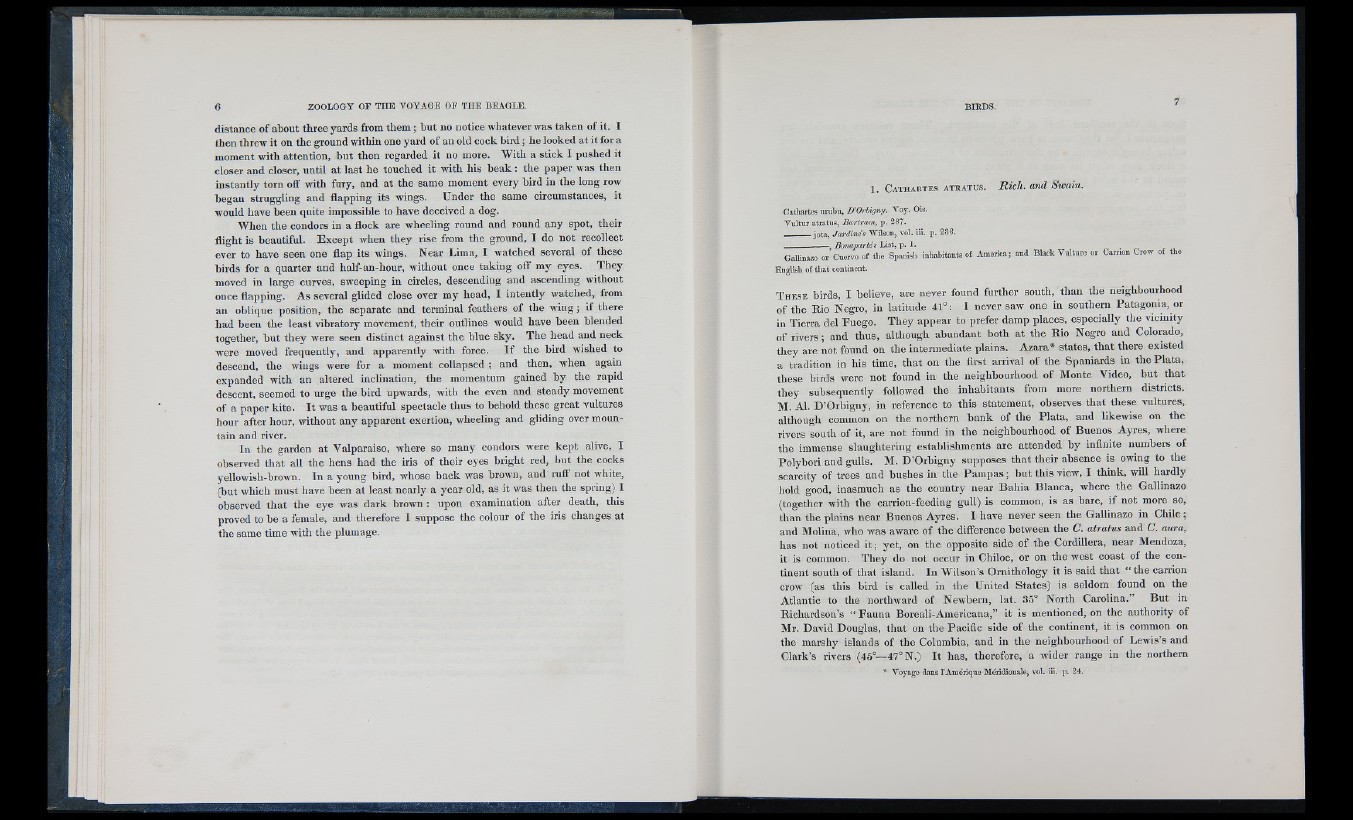
I
IfS
lym
ir
lir
I
6 ZOOLOGY OP TH E VOYAGE OF TH E BEAGLE.
distance of about three yards from them; but no notice whatever was taken of it. I
then threw it on the ground within one yard of an old cock bird; he looked at it for a
moment with attention, but then regarded it no more. With a stick I pushed it
closer and closer, until at last he touched it with his b e ak : the paper was then
instantly torn off with fury, and at the same moment every bird in the long row
began struggling and flapping its wings. Under the same circumstances, it
would have been quite impossible to have deceived a dog.
When the condors in a flock are wheeling round and round any spot, their
flight is beautiful. Except when they rise from the ground, I do not recollect
ever to have seen one flap its wings. Near Lima, I watched several of these
birds for a quarter and half-an-hour, without once taking off my eyes. They
moved in large curves, sweeping in circles, descending and ascending without
once flapping. As several glided close over my head, I intently watched, from
an oblique position, the separate and terminal feathers of the w in g ; if there
had been the least vibratory movement, their outlines would have been blended
together, but they were seen distinct against the blue sky. The head and neck
were moved frequently, and apparently with force. I f the bird wished to
descend, the wings were for a moment collapsed ; and then, when again
expanded with an altered inclination, the momentum gained by the rapid
descent, seemed to urge the bird upwards, with the even and steady movement
of a paper kite. It was a beautiful spectacle thus to behold these great vultures
hour after hour, without any apparent exertion, wheeling and gliding over mountain
and river.
In the garden at Valparaiso, where so many condors were kept alive, I
observed that all the hens had the iris of their eyes bright red, but the cocks
yellowish-brown. In a young bird, whose back was brown, and ruff not white,
(but which must have been at least nearly a year old, as it was then the spring) I
observed that the eye was dark brown : upon examination after death, this
proved to be a female, and therefore I suppose the colour of the iris changes at
the same time with the plumage.
1 . C a t h a r t e s a t r a t u s . Rich, and Swain.
Cathartes urubii, IfOrbigny. Y oy. Ois.
Vultur atratus, Bartram, p. 287.
jota. Jardines Wilson, vol. iii. p. 280.
---------------- , Bonaparte's I- ^ . r. p ..i
Galliuazo or Cuervo of the Spanish inhabitants of America; and Black Vulture or Carnon Crow of the
English of that continent.
T h e s e birds, I believe, are never found further south, than the neighbourhood
of the Rio Negro, in latitude 41°: I never saw one in southern Patagonia, or
in Tierra del Fuego. They appear to prefer damp places, especially the vicinity
of rivers ; and thus, although abundant both at the Rio Negro and Colorado,
they are not found on the intermediate plains. Azara* states, that there existed
a tradition In his time, that on the first arrival of the Spaniards in the Plata,
these birds were not found in the neighbourhood of Monte Video, but that
they subsequently followed the inhabitants from more northern districts.
M, Al. D ’Orhigny, in reference to this statement, observes that these vultures,
although common on the northern hank of the Plata, and likewise on the
rivers south of it, are not found in the neighbourhood of Buenos Ayres, where
the immense slaughtering establishments are attended by infinite numbers of
Polybori and gulls. M. D ’Orhigny supposes that their absence is owing to the
scarcity of trees and hushes in the Pampas ; but this view, I think, will hardly
hold good, inasmuch as the country near Bahia Blanca, where the Gallinazo
(together with the carrion-feeding gull) is common, is as bare, if not more so,
than the plains near Buenos Ayres. I have never seen the Gallinazo in Chile ;
and Molina, who was aware of the difference between the C. atratus and C. aura.
has not noticed it ; yet, on the opposite side of the Cordillera, near Mendoza,
it is common. They do not occur in Chiloe, or on the west coast of the continent
south of that island. In Wilson’s Ornithology it is said that “ the carrion
crow (as this bird is called in the United States) is seldom found on the
Atlantic to the northward of Newhern, lat. 33° North Carolina.” But in
Richardson’s “ Fauna Boreali-Americana,” it is mentioned, on the authority of
Mr. David Douglas, that on the Pacific side of the continent, it is common on
the marshy islands of the Columbia, and in the neighbourhood of Lewis’s and
Clark’s rivers (4S°—47°N.) It has, therefore, a wider range in the northern
* Voyage dans l’Amérique Méridionale, vol. iii. p. 24.